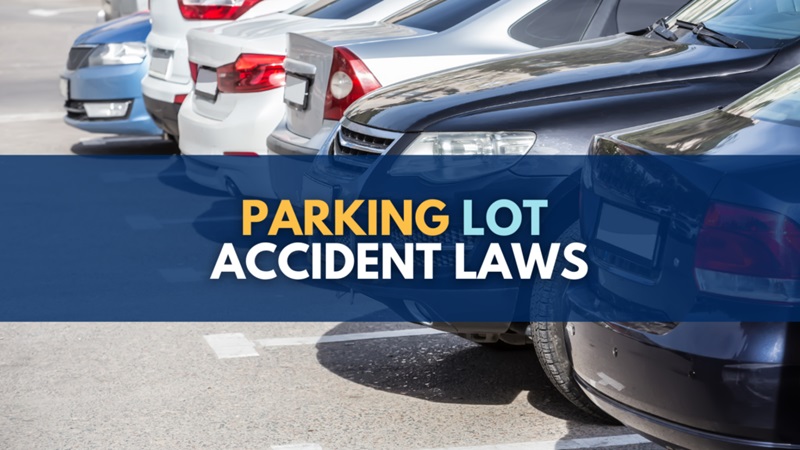Determining Fault in a Parking Lot Accident

Many parking lot accidents often stem from the distraction of drivers or other parking lot users. Another common cause is drivers speeding or failing to yield to pedestrians.
Poor visibility or obstructed views from large vehicles can also contribute to accidents. By understanding parking lot car accident laws, you can protect yourself in the event of such accidents.
Rules For Determining Fault in a Parking Lot Accident
Determining fault in a parking lot accident can be complex, but here are some rules to simplify this process:
Right of Way
The driver who has the right of way typically holds less responsibility. However, this can vary depending on local traffic laws and the specific circumstances of the accident.
Speed
Excessive speed is often a factor in parking lot accidents. If one driver was speeding, they may be deemed at fault, especially if it contributed to the collision.
Signs and Markings
Ignoring signs or pavement markings such as stop signs, yield signs, or painted lines can indicate fault. Drivers must adhere to these regulations, and failure to do so can result in liability.
Backing Up
When a driver is backing out of a parking space, they must yield to oncoming traffic. If they fail to do so and cause an accident, they are likely to be held accountable.
Visibility
Both drivers are responsible for ensuring they have clear visibility while maneuvering in a parking lot. Obstructed views from objects or other vehicles can affect fault determination.
Distractions
Being distracted by a phone, passengers, or other factors significantly increases the likelihood of an accident. If distraction plays a role, the distracted driver may be considered at fault.
Vehicle Maintenance
Poorly maintained vehicles, such as those with malfunctioning brakes or lights, can contribute to accidents. Drivers must ensure their vehicles are in safe working condition.
Pedestrian Right of Way
Pedestrians in parking lots typically have the right of way. Drivers must yield to pedestrians at all times, and failing to do so can lead to fault being assigned to the driver.
Lane Discipline
Parking lots often have designated lanes and traffic flow patterns. Deviating from these lanes or driving against the flow of traffic can result in a fault being assigned to the driver responsible for the deviation.
Witness Testimony and Evidence
Eyewitness accounts and any available evidence, such as security camera footage or vehicle damage patterns, can help determine fault. It’s essential to gather as much information as possible at the scene to support fault determination in a parking lot accident.
Strategies for Preventing Parking Lot Accidents
Below are 5 effective strategies for preventing parking lot accidents:
Mindful Driving
Stay alert and focused while navigating parking lots. Avoid distractions like texting or adjusting the radio, as even momentary lapses in attention can lead to accidents.
Reduce Speed
Slow down when entering, exiting, or maneuvering within parking lots. Lowering your speed gives you more time to react to unexpected situations and reduces the severity of potential accidents.
Use Signals
Signal your intentions when turning, changing lanes, or backing out of parking spaces. This alerts other drivers and pedestrians to your movements, reducing the risk of collisions.
Be Pedestrian Aware
Always yield to pedestrians in parking lots. Be especially cautious near crosswalks, sidewalks, and pedestrian-heavy areas, and give pedestrians the right of way.
Parking Safely
Park within designated spots and avoid parking in areas where visibility is obstructed. Ensure your vehicle is fully within the parking space to prevent accidents while backing out. Additionally, be mindful of other vehicles when opening car doors to avoid causing damage to neighboring vehicles.
Actions to Take Following A Parking Lot Accident
Following a parking lot accident, it’s advisable to take the following actions:
Check for Injuries
First and foremost, ensure everyone involved in the accident is safe. If anyone is injured, call emergency services immediately.
Exchange Information
Exchange contact and insurance information with the other parties involved in the accident. Obtain names, phone numbers, addresses, license plate numbers, and insurance policy details.
Document the Scene
Take photos of the accident scene, including:
- The vehicles involved
- Any damage sustained, and
- The surrounding area.
This documentation can serve as crucial evidence during insurance claims or legal proceedings.
Notify Authorities
Depending on the severity of the accident and local regulations, you may need to notify law enforcement. They can file an official report, which may be required by insurance companies.
Report to Insurance
Contact your insurance provider as soon as possible to report the accident and initiate the claims process. Provide them with all relevant information and cooperate fully with their investigation.
Without legal support, determining liability in a parking lot accident can be challenging. Your lawyer will ensure responsibility for the accident is assigned to the right parties while protecting your rights.